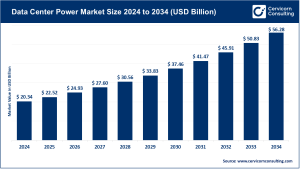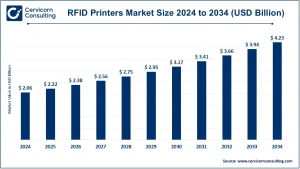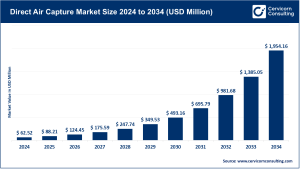Market Overview
The global AI infrastructure market was estimated at USD 46.73 billion in 2024 and is forecasted to reach nearly USD 502.42 billion by 2034, expanding at an impressive CAGR of 26.81% between 2025 and 2034.
AI infrastructure refers to the integrated combination of hardware, software, and networking components essential for training, deploying, and scaling artificial intelligence (AI) models. This includes GPUs, AI accelerators, high-speed networking systems, and cloud platforms that support the massive computational power required for machine learning (ML) and generative AI applications.
Key Market Trends
1. Surge in AI-Optimized Hardware Adoption
The market is witnessing a transition toward specialized chips and GPUs engineered for faster AI model training and inference. Companies like NVIDIA, AMD, and Intel continue to innovate, producing high-performance and energy-efficient processors. NVIDIA’s H100 and Hopper architectures have become key benchmarks for large-scale AI workloads.
2. Rapid Expansion of Cloud-Based AI Infrastructure
Cloud leaders such as Amazon Web Services (AWS), Google Cloud, and Microsoft Azure are increasing their data center footprints to manage escalating AI workloads. The rise of AI-as-a-Service (AIaaS) is allowing enterprises to deploy and scale AI capabilities efficiently without massive upfront investments.
3. Integration of Edge AI and Hybrid Infrastructure
Enterprises are increasingly adopting edge-based AI systems to minimize latency and enhance real-time data processing. Providers like Hewlett Packard Enterprise (HPE) and Dell Technologies are introducing edge-optimized servers through platforms like GreenLake and PowerEdge to support decentralized AI deployment.
4. Growing Emphasis on Sustainability
As AI computing becomes more energy-intensive, the industry is focusing on green data centers and energy-efficient chips. Tech giants are investing in liquid cooling, renewable-powered data centers, and AI-driven energy optimization to achieve sustainability objectives.
5. Convergence of AI, HPC, and 5G
The blending of AI infrastructure with high-performance computing (HPC) and 5G networks is unlocking opportunities in autonomous mobility, smart manufacturing, and real-time analytics. This convergence is driving collaboration across semiconductor, telecom, and cloud sectors.
👉 Get a Free Sample: https://www.cervicornconsulting.com/sample/2786
Market Drivers
Exponential Growth in AI Workloads
The explosion of large language models (LLMs), generative AI, and computer vision applications is fueling significant demand for scalable AI infrastructure across industries such as healthcare, finance, retail, and automotive.
Massive Capital Investments by Technology Giants
Leading firms are investing heavily in expanding their AI infrastructure capabilities. Microsoft’s multi-billion-dollar collaboration with OpenAI in 2024 highlights the strategic importance of AI-driven data centers.
Government and Policy Initiatives
Governments are strengthening AI ecosystems through national AI strategies and funding programs. Examples include India’s Digital India, the EU’s AI Act, and the U.S. AI R&D Act, which collectively encourage infrastructure development and research investments.
Advancements in Semiconductor and Networking Technologies
Innovations in next-generation GPUs, AI accelerators, and high-speed interconnects such as NVLink and InfiniBand are improving efficiency, reducing training time, and lowering costs for AI deployment.
Rising Enterprise Digital Transformation
Global enterprises are integrating AI-driven automation and analytics into their operations, leading to sustained demand for cloud-native and hybrid AI infrastructure solutions.
Impact of Trends and Drivers
-
Cloud providers are reaping major benefits as large-scale AI workloads drive collaboration with hardware and semiconductor partners.
-
Chip manufacturers are experiencing record demand for training and inference processors.
-
Regional markets, particularly North America and Asia-Pacific, are leading adoption due to technological readiness and supportive policy frameworks.
-
Enterprise adoption in sectors like healthcare, finance, and manufacturing continues to accelerate due to measurable ROI from AI integration.
Challenges and Opportunities
Challenges: High infrastructure costs, energy consumption, and scalability issues remain pressing concerns, along with growing data privacy and security challenges.
Opportunities: Emerging innovations in quantum computing, neuromorphic chips, and AI optimization software are expected to redefine computational efficiency in the coming decade.
Future Outlook
The AI infrastructure market is on the verge of a massive growth phase as enterprises move from AI experimentation to large-scale deployment. By 2034, the market is expected to surpass USD 502 billion, with emphasis on energy-efficient architectures, edge computing models, and AI-specific cloud solutions. This evolution will mark a pivotal era in the global digital transformation journey.
For detailed insights and forecasts, visit Cervicorn Consulting.


